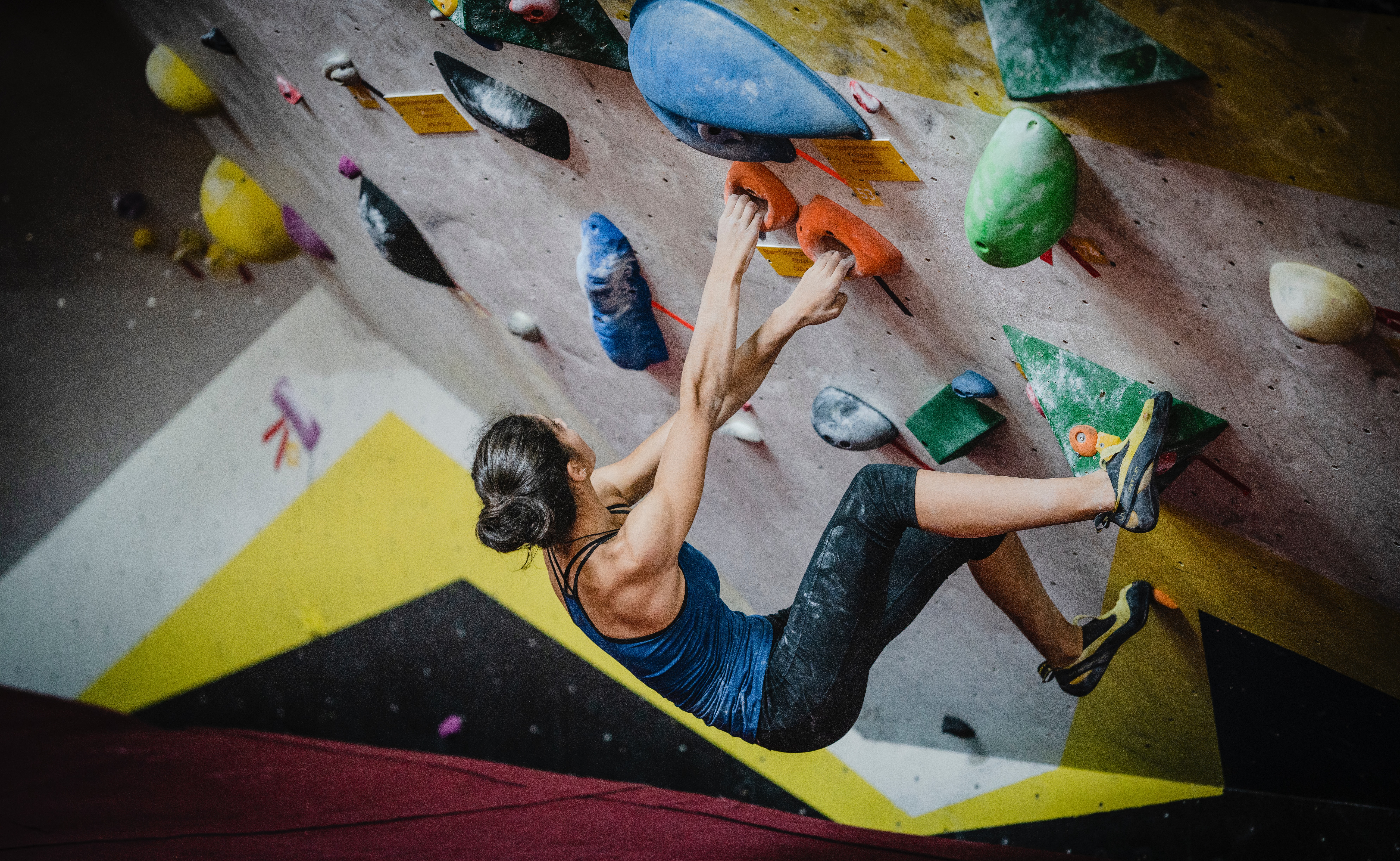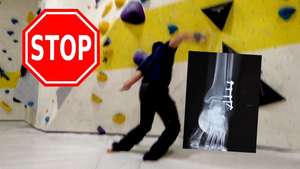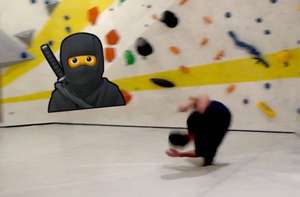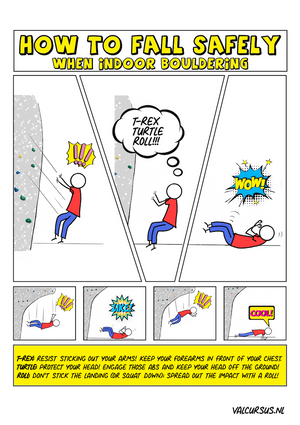
How to fall safely while indoor bouldering
The ability to fall safely is an essential skill when bouldering. Not only will this reduce the chance of injury, it will also increase the amount of fun you'll have!
Basic falling techniques (do this every time):
Advanced falling techniques (high heel hooks and dynos): 
Note that the information on this page only related to indoor bouldering!
Table of contents:
- The basic roll; do this every time you fall!
- Intermediate techniques; for high heel hooks and toe hooks
- Advanced techniques; falling safely while doing crazy dynos
Put up this free poster in your bouldering gym! It's the shortest possible way to explain how to fall safely. Download poster as PDF.

Big thanks to Emily Coomber for the artwork!
The Basics of falling safely
The most important and basic falling technique is the basic roll. Land on your feet, knees shoulder width apart, then absorb the first part of the impact with your legs by bending them to 90 degrees (maximum! If you squat lower you will end up hurting your back!) and absorb the rest of the impact by rolling backwards. Keep your arms in a T-Rex position so that you resist the urge to stick them out (which is very dangerous), round your back to allow for a smooth roll and tense your abs to keep your head up and prevent it from hitting the mat. The bouldering mat is great for absorbing impact, but unfortunately landing on a soft surface can increase the chances of twisting your ankle. So again, it is very important to absorb a large part of the impact by rolling.
Things to watch out for:
- Arms and head do NOT touch the ground!
- Don't land while turning or twisting as this could hurt your knees or ankles.
- When climbing a slab (or above module), you may want to push away on the wall to prevent hitting any holds on the way down.
- Falling from low can be especially dangerous, because you might hit the mat before you even realise what's going on. Brush the foot holds to reduce the chance of this happening.
- Even a sit start can be dangerous (as your legs can't absorb the impact) so be sure to apply the basic roll to spread out the impact of falling.
- Make sure you ALWAYS apply this basic technique, repeat it every single session so that it becomes ingrained in your muscle memory.
- You can tell if you're applying this technique correctly by listening: if you hear 2 distinct impact sounds, it probably means your legs took 100% of the impact and the roll afterwards really didn't do anything. Keep practising this technique until you hear a single impact sound as you land, which indicated that the legs and back roll effectively spread out the impact of landing.
- If you're irrationally scared of falling when bouldering, then practise the rolling exercises below (see "advanced") to get more comfortable and confident with landing on the mat.
Intermediate: learning to fall flat
The basic roll will work in most circumstances, but as you start getting to the more difficult bouldering grades there are times when your body is completely horizontal. When this happens, you may not be able to land on your feet in the event of a fall. Therefore, once you start using high heel hooks or toe hooks, it is important you also learn how to safely fall flat.
Things to watch out for:
- When falling flat on your back;
- keep your arms in a T-Rex position so that you resist the urge to stick them out
- tense your abs to keep your head off the ground.
- Martial artists may use their arms to slap the ground and further break their fall, but note that this is not necessary as the bouldering mat is already sufficient to absorb the impact of the fall. Therefore, unless you are familiar with the technique, I suggest you keep your arms in a T-Rex position at all times.
- It's OK to ask for a spot: somebody who puts a hand in between your shoulder blades so that if you fall while horizontal - the hand will buy you some time to land feet first.
- When falling forwards;
- Keep your arms in a T-Rex position and keep them there so that you will use your entire forearm (not just your hand or wrist) to break the fall.
- As your forearms hit the mat to break the fall, you can either have open hands (palms down) or fists (thumbs up).
- Look to the side to prevent your face from hitting the mat
- Falling like this is not comfortable, so brace for impact and tense your core!
Practise these techniques by squatting down and falling forwards or backwards from there. Once that is comfortable you can slowly start standing higher and higher until eventually you practise this technique will standing completely upright. To practise this technique in a more realistic situation, find an overhanging wall, put up a high heel hook so that your body is horizontal and fall flat on your back from there!
Dynos and the art of advanced falling techniques
So you're about to do a paddle (triple) dyno..? Awesome! You can fall in unpredictable ways when dynoing, or fall while having a lot of momentum. Deal with this by learning the shoulder roll!
Things to watch out for:
- Practise the shoulder roll without using your hands at first; kneel down, spread out your arms, now let your shoulder touch the ground and then push forwards to complete the roll.
- As you get better, try to make sure your head does not touch the ground at all!
- Time to learn how amazing shoulder rolls are at breaking falls: place a seat cushion or other obstacle and roll over it. Use an obstacle that is about knee high at first, then build it up. If it's comfortable, hop into the shoulder roll.
- Now that you are comfortable and confident with the shoulder roll (and being on the mat in general): it's time to mimic a failed sideways double dyno. Find an overhanging wall with a nice jug, grab it and swing your legs side to side. Now let go, land on your feet and immediately transition into the shoulder roll. When done properly there is no excessive impact on any limbs, your head does not touch the ground, and you look like a total badass!